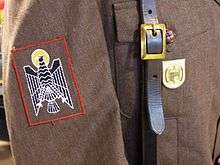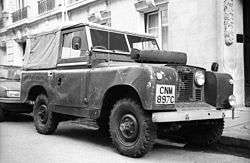Armed Police Corps
The Policía Armada (English: Armed Police), conventional long names Cuerpo de Policía Armada y de Tráfico and Fuerzas de Policía Armada, —popularly known as los grises (English: the grey ones) owing to the color of their uniforms— was an armed urban police force of Spain established by the Francoist regime in 1939 to enforce the repression of all opposition to the regime. Its mission was "total and permanent vigilance, as well as repression when deemed necessary."[1]
| Armed Police Policía Armada | |
|---|---|
 | |
| Common name | Fuerzas de Policía Armada |
| Abbreviation | FPA |
| Agency overview | |
| Formed | 3 August 1939 |
| Preceding agency | |
| Dissolved | 4 December 1978 |
| Superseding agency | Cuerpo Nacional de Policía |
| Employees | 20,000 est. 1968 |
| Jurisdictional structure | |
| National agency | Francoist Spain |
| Operations jurisdiction | Francoist Spain |
| Governing body | Ministry of Governance]] |
| General nature | |
| Operational structure | |
| Overviewed by | Directorate General of Security |
| Headquarters | Madrid |
| Parent agency | Francoist Armed Forces |

.jpg)

The first commander of the Policía Armada was General Antonio Sagardía Ramos. In its first years of operation the corps was inadequately equipped in armament and vehicles but this situation would be steadily straightened out.[2]
History
Following the overthrow of the Second Spanish Republic in April 1939, the Francoist Spain initially relied on the Army in order to handle public order issues.[3] By means of two sets of laws issued on 3 August 1939 and 8 March 1941 the Spanish State reorganized the police forces of Spain and established the Armed Police as a gendarmerie style national armed police that could be used to suppress disturbance of the public order and political organization in urban areas.[4] Armed and trained for this purpose, it was intended to provide a more effective force for internal security duties in the large cities of Spain than the Guardia Civil that operated mainly in rural areas.[3]
At the time of the Spanish coup of July 1936 that marked the onset of the Spanish Civil War most of the members of the preceding equivalent corps, the Guardia de Asalto had stayed loyal to the Republican government and many of their units fought valiantly in the battlefronts against the Francoist armies and their allies.[5] This display of loyalty towards the Spanish Republic brought about the disbandment of the corps by General Franco at the end of the Civil War. The members of the Guardia de Asalto who had survived the war and the ensuing Francoist purges were made part of the Policía Armada, the corps that replaced it.[6]
The Policía Armada was placed under the Directorate-General of Security (Dirección General de Seguridad) of the Spanish Ministry of the Interior (Ministerio de la Gobernación) and operated in most large population centers in Spain. Towards the last phase of the Francoist State it had earned a wide reputation as a ferocious corps, especially in the largest cities such as Madrid, Barcelona, Bilbao and Valencia, as well as the industrial areas of Spain such as parts of Asturias and the Basque country, where its well-equipped anti-riot units were ruthless and effective in quelling demonstrations by university students and workers that were often very large.
In the months after the death of the caudillo the Armed Police actively cracked down on protests and political rallies, continuing the infamous riot control operations of the Francoist State. Viewed as unpopular and too closely identified with Franco's Spain, the Policía Armada was slightly reorganized in the first years of the Spanish transition to democracy, when brown uniforms replaced the former grey ones, among other cosmetic changes.[7] The effort, however, revealed itself hopeless for the brutal and harsh image of the corps could not be improved and in 1979 the Armed Police was replaced by the Cuerpo Nacional de Policía (National Police Corps), later civilianized in a 1986 merger with the Cuerpo Superior de Policía (Superior Police Corps).[8]
As its other function was traffic and road safety, its duties in all national highways outside the metropolitan areas ended in June 1959, when the Civil Guard took over.
Human rights abuses
The Policía Armada, together with the Guardia Civil, became notorious during the decades of Francoism for its ruthless methods and for widespread human rights abuses against its victims. Indiscriminate beatings of detainees and torture, with or without interrogation, were commonplace in the many police stations (Comisarías) as well as in the headquarters of the Armed Police. Interrogations usually included a member of the Brigada Político-Social, the Francoist political repression wing.[9] The brutal image of the Spanish police would be so pervasive that it has continued to haunt the National Police Corps that replaced the Policía Armada following the Spanish Transition to this day.[10]
Ranks
The ranks and insignia of the Policía Armada displayed its military character and structure.[11] When the National Police Corps replaced it in 1979, it would take 7 years before the rank system was replaced.
Officers
Spain (1939–1977) |
 |
 |
 |
 |
 |
 |
 |
 |
| General de División (Commissioner) |
General de Brigada (Assistant Commissioner) |
Coronel (Chief Superintendent) |
Teniente Coronel (Superintendent) |
Comandante | Capitán | Teniente | Alférez (Station Inspector) |
Non-commissioned ranks
Spain (1939–1977) |
 |
 |
 |
 |
 |
 |
 |
 |
| Subteniente (Sub-inspector) |
Brigada (Head Constable) |
Sargento Primero (Staff Sergeant) |
Sargento (Sergeant) |
Cabo Primero (Corporal) |
Cabo (Lance Corporal) |
Policía de Primera (Senior Constable) |
Policía (Policeman, Constable) |
Vehicles


The Armed Police used different types of vehicles until its disbandment in 1978. Their registration plates had the letters FPA (Fuerzas de Policía Armada) in black over white.[12]
The Mobile Units (Banderas Móviles) used the following vehicles:
- Land Rover Santana S-II four-wheel drive vehicles[13]
- Land Rover Santana S-III four-wheel drive vehicles in their short and long versions
- Avia buses
- Ebro B-45 trucks
- Sanglas 400 motorcycles
The General Reserve Companies (Compañías de Reserva General) used the following:
The Garrison Units (Banderas de Guarnición) were equipped with:
- SEAT 1400 cars
- SEAT 1500 cars
- SEAT 124 station wagon cars
- Sava J4 patrol wagons
- Traffic patrol bicycles
The Cavalry Platoons (Caballería) used Avia 2500 trucks that could carry four horses each for their anti-riot operations, troops were only armed with batons and pistons while sporting lances for ceremonial parades.
See also
References
- ... vigilancia total y permanente, así como de represión cuando fuera necesario... "Los grises vuelven a España".
- Mariano Aguilar (1999); El ejército español durante el franquismo. Madrid: Ediciones Akal. ISBN 84-460-0962-5 p. 74
- Mariano Aguilar (1999); p. 58
- Mariano Aguilar (1999); p. 62
- Guardia de Asalto at Spartacus Educational
- Farrás, Salvador. Fuerzas de orden público y transición política (y II). La Policía Armada. Diario 16. 25/10/1977.]
- EL PAIS - La Policía Armada vestirá desde principio de 1979 de color marrón
- Ramón Tamames, (1974). Historia de España Alfaguara VII. La República. La Era de Franco. Madrid: Alianza Editorial
- Alberto Gómez Roda , La tortura en España bajo el franquismo. Roderic
- Publico - España ha vivido desde 2004 más de 6.600 casos de tortura o malos tratos policiales
- Mariano Aguilar (1999); pág. 63
- Matrículas de vehículos en España
- Exposición de vehículos de policía en Alcalá de Henares
- Police Water Cannon in Parbayon, Spain ' 96
External links

- The Grises charging in Vitoria in 1976
- Himno de la Policia Armada- Los Grises
- Spanish Police Badges